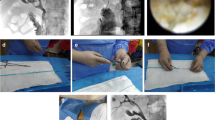Abstract
Extraction of stones from the bile ducts via standard endoscopic techniques, a percutaneous transhepatic approach, or a T-tube track can be unsuccessful. We report our preliminary experience with a combination of percutaneous cholangioscopy and dye laser lithotripsy. Flash lamp-excited dye laser (504 nm) lithotripsy delivered by percutaneous cholangioscopy (12 F) was evaluated in 13 patients with stones in the bile ducts. Conventional endoscopic treatment had not been attempted in 4 patients after hepaticojejunostomy and had failed in 3 patients after gastric bypass surgery or gastrectomy, and in 6 patients because of technical difficulties, i. e. due mainly to largeness of stones. In 12 patients a percutaneous transhepatic route was used. In 1 patient the T-tube track was used as access to the bile ducts. Laser lithotripsy resulted in successful fragmentation of stones in 12 patients (92%). The bile ducts cleared spontaneously in 2 patients only. Using additional techniques, i. e. sphincterotomy and stent insertion, the overall combined success rate for duct clearance after laser fragmentation was 100%. Four patients had a retrograde endoscopic sphincterotomy after failed attempts for stone removal at endoscopic retrograde cholangioscopy. Two patients had an antegrade fluoroscopically monitored sphincterotomy. Bleeding complications occured in 2 patients. This accounted for a high rate (15%) of severe complications. The intrahepatic bleeding in 1 patient was due to an intrahepatic vessel injury by the 13-F sheath. The periampullary bleeding in the other patient occurred after an antegrade papillotomy. Pulsed dye laser lithotripsy proved to be an effective technique in patients with difficult bile duct stones. The main problem of a percutaneous approach is the complete removal of the fragmented stones, which requires additional procedures in most cases. The percutaneous access is time-consuming and bears a relatively high risk of major bleeding complications. It should therefore be restricted to cases in which conventional endoscopic procedures are impossible or unsuccessful.
Similar content being viewed by others
References
Cotton PB (1984) Endoscopic management of bile duct stones (apples and oranges). Gut 25: 587–597
Goldberg HI, Gordon R (1991) Diagnostic and interventional procedures for the biliary tract. Curr Opin Radiol 3: 453–462
Ott DJ, Gilliam JH, Zagoria RJ, Young GP (1992) Interventional endoscopy of the biliary and pancreatic ducts: current indications and methods. AJR 158: 243–250
Chung SC, Leung JW, Leong HT, Li AK (1991) Mechanical lithotripsy of large common bile duct stones using a basket. Br J Surg 78: 1448–1450
Venbrux AC, Robbins KV, Savader SJ, Mitchell SE, Widlus DM, Osterman FA (1991) Endoscopy as an adjunct to biliary radiologic intervention. Radiology 180: 55–361
Dretler SP (1988) Laser lithotripsy: a review of 20 years of research and clinical applications. Lasers Surg Med 8: 341–356
Cotton PB, Kozarek RA, Schapiro RH et al. (1990) Endoscopic laser lithotripsy of large bile duct stones. Gastroenterology 99: 1128–1133
Ponchon T, Gagnon P, Valette PJ, Henry L, Chavaillon A, Thieulin F (1991) Pulsed dye laser lithotripsy of bile duct stones. Gastroenterology 100: 1730–1736
Dawson SL, Mueller PR, Lee MJ, Saini S, Kelsey P, Nishioka NS (1992) Treatment of bile duct stones by laser lithotripsy: results in 12 patients. AJR 58: 1007–1009
Orii K, Ozaki A, Takase Y, Iwasaki Y (1983) Lithotomy of intrahepatic and choledochal stones with YAG laser. Surg Gynecol Obstet 156: 455–458
Lux G, Ell C, Hochberger J, Mueller D, Demling L (1986) The first successful endoscopic retrograde laser lithotripsy of common bile duct stones in man using a pulsed neodymium-YAG laser. Endoscopy 18: 144–145
Ell C, Lux G, Hochberger J, Mueller D, Demling L (1988) Laser lithotripsy of common bile duct stones. Gut 29: 746–751
Thomas S, Pensel J, Engelhardt R, Meyer W, Hofstetter AG (1988) The pulsed dye laser versus the Q-switched Nd: YAG laser in laser-induced shock-wave lithotripsy. Lasers Surg Med 8: 363–370
ReMine SG, Aretz HT, Setzer SE, Manni JG, Shapshay SM (1988) Holmium laser (2.1 μm) for biliary stone dissolution and ductal tissue effects. Lasers Surg Med 8: A191
Nishioka NS, Teng P, Deutsch TF, Anderson RR (1987) Mechanism of laser-induced fragmentation of urinary and biliary calculi. Lasers Life Sci 1: 231–245
Duda SH, Huppert PE, Arndt V, Wehrmann M, Haase KK, Claussen CD (1992) In vitro and clinical feasibility study with an over-the-wire delivery system for pulsed dye laser angioplasty. J Vasc Interv Radiol 3: 59–65
Watson GM, Murray S, Dretler SP, Parrish JA (1987) The pulsed dye laser for fragmenting urinary calculi. J Urol 138: 195–198
Nishioka NS, Levins PC, Murray SC, Parrish JA, Anderson RR (1988) Fragmentation of biliary calculi with tunable dye lasers. Gastroentorology 93: 250–255
Lehman CD, Goldman ML, Baron RL, Richardson ML, Starr FE, Lee SP (1991) Gallstone susceptibility to in vitro fragmentation by a 480-nm pulsed dye laser. Correlation with computed tomography characteristics. Invest Radiol 26: 799–803
Dayton MT, Decker DL, McClane R, Dixon JA (1988) A comparison of wall heat generated during gallstone fragmentation with Nd: YAG, copper vapor, and flashlamp pumped dye lasers. Gastroenterology 94: A534
O'Leary DP, Cave DR, Greenfield A, Kuligowska E, Birkett DH (1991) Endoscopic pulsed dye laser lithotripsy of gallbladder calculi in vivo. Gastrointest Endosc 37: 143–146
Chen MF, Jan YY (1990) Percutaneous transhepatic cholangioscopic lithotripsy. Br J Surg 77: 530–532
Bonnel DH, Liguory CE, Cornud FE, Lefebvre JF (1991) Common bile duct and intrahepatic stones: results of transhepatic electrohydraulic lithotripsy in 50 patients. Radiology 180: 345–348
Picus D, Weyman PJ, Marx MV (1989) Role of percutaneous intracorporeal electrohydraulic lithotripsy in the treatment of biliary tract calculi. Radiology 170: 989–993
Harrison J, Morris DL, Haynes J, Hitchcock A, Womack C, Wherry DC (1987) Electrohydraulic lithotripsy of gallstones —in vitro and animal studies. Gut 28: 267–272
Author information
Authors and Affiliations
Additional information
Correspondence to: H.-J. Brambs
Rights and permissions
About this article
Cite this article
Brambs, H.J., Duda, S.H., Rieber, A. et al. Treatment of bile duct stones: value of laser lithotripsy delivered via percutaneous endoscopy. Eur. Radiol. 6, 734–740 (1996). https://doi.org/10.1007/BF00187681
Received:
Accepted:
Issue Date:
DOI: https://doi.org/10.1007/BF00187681




